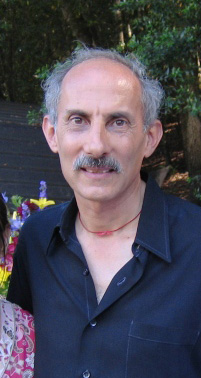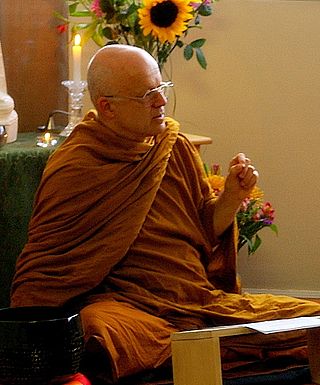Related Research Articles

In Buddhism, the Four Noble Truths are "the truths of the Noble Ones", the truths or realities for the "spiritually worthy ones". The truths are:
The relationship between Buddhism and science is a subject of contemporary discussion and debate among Buddhists, scientists and scholars of Buddhism. Historically, Buddhism encompasses many types of beliefs, traditions and practices, so it is difficult to assert any single "Buddhism" in relation to science. Similarly, the issue of what "science" refers to remains a subject of debate, and there is no single view on this issue. Those who compare science with Buddhism may use "science" to refer to "a method of sober and rational investigation" or may refer to specific scientific theories, methods or technologies.
Rebirth in Buddhism refers to the teaching that the actions of a sentient being lead to a new existence after death, in an endless cycle called saṃsāra. This cycle is considered to be dukkha, unsatisfactory and painful. The cycle stops only if moksha (liberation) is achieved by insight and the extinguishing of craving. Rebirth is one of the foundational doctrines of Buddhism, along with karma, Nirvana and liberation. Rebirth was a key teaching of early Buddhism along with the doctrine of karma. In Early Buddhist Sources, the Buddha claims to have knowledge of his many past lives. Rebirth and other concepts of the afterlife have been interpreted in different ways by different Buddhist traditions.
In Mahayana Buddhism, bodhicitta,, is the mind (citta) that is aimed at awakening (bodhi), with wisdom and compassion for the benefit of all sentient beings. Bodhicitta is the defining quality of the Mahayana bodhisattva and the act of giving rise to bodhicitta (bodhicittotpāda) is what makes a bodhisattva a bodhisattva. The Daśabhūmika Sūtra explains that the arising of bodhicitta is the first step in the bodhisattva's career.

Geshe Kelsang Gyatso was a Buddhist monk, meditation teacher, scholar, and author. He was the founder and spiritual director of the New Kadampa Tradition-International Kadampa Buddhist Union (NKT-IKBU), a registered non-profit, modern Buddhist organization that came out of the Gelugpa school/lineage. 1,300 centres around the world, including temples, city temples and retreat centres offer an accessible approach to ancient wisdom.
Lamrim is a Tibetan Buddhist textual form for presenting the stages in the complete path to enlightenment as taught by Buddha. In Tibetan Buddhist history there have been many different versions of lamrim, presented by different teachers of the Nyingma, Kagyu and Gelug schools. However, all versions of the lamrim are elaborations of Atiśa's 11th-century root text A Lamp for the Path to Enlightenment (Bodhipathapradīpa).

Thrangu Rinpoche was born in 1933 in Kham, Tibet. He is deemed to be a prominent tulku in the Kagyu school of Tibetan Buddhism, the ninth reincarnation in his particular line. His full name and title is the Very Venerable Ninth Khenchen Thrangu Tulku, Karma Lodrö Lungrik Maway Senge. The academic title Khenchen denotes great scholarly accomplishment, and the term Rinpoche is a Tibetan devotional title which may be accorded to respected teachers and exemplars.

Surya Das is an American lama in the Tibetan Buddhist tradition. He is a poet, chantmaster, spiritual activist, author of many popular works on Buddhism, meditation teacher and spokesperson for Buddhism in the West. He has long been involved in charitable relief projects in the developing world and in interfaith dialogue.

Jack Kornfield is an American writer and teacher in the Vipassana movement in American Theravada Buddhism. He trained as a Buddhist monk in Thailand, Burma and India, first as a student of the Thai forest master Ajahn Chah and Mahasi Sayadaw of Burma. He has taught mindfulness meditation worldwide since 1974. In 1975, he co-founded the Insight Meditation Society in Barre, Massachusetts, with Sharon Salzberg and Joseph Goldstein, and subsequently in 1987, Spirit Rock Meditation Center in Woodacre, California. Kornfield has worked as a peacemaker and activist, organized teacher trainings, and led international gatherings of Buddhist teachers including the Dalai Lama.

Gangaji is an American born spiritual teacher and author. She lives in Ashland, Oregon, with her husband, fellow spiritual teacher Eli Jaxon-Bear.

Ṭhānissaro Bhikkhu is an American Buddhist monk and author. Belonging to the Thai Forest Tradition, for 10 years he studied under the forest master Ajahn Fuang Jotiko. Since 1993 he has served as abbot of the Metta Forest Monastery in San Diego County, California—the first monastery in the Thai Forest Tradition in the US—which he cofounded with Ajahn Suwat Suvaco.

Sharon Salzberg is a New York Times bestselling author and teacher of Buddhist meditation practices in the West. In 1974, she co-founded the Insight Meditation Society at Barre, Massachusetts, with Jack Kornfield and Joseph Goldstein. Her emphasis is on vipassanā (insight) and mettā (loving-kindness) methods, and has been leading meditation retreats around the world for over three decades. All of these methods have their origins in the Theravada Buddhist tradition. Her books include Lovingkindness: The Revolutionary Art of Happiness (1995), A Heart as Wide as the World (1999), Real Happiness - The Power of Meditation: A 28-Day Program (2010), which was on The New York Times Best Seller list in 2011, and the follow-up Real Happiness at Work (2013). She runs a Metta Hour podcast, and contributes monthly to a column On Being.

Buddhism includes an analysis of human psychology, emotion, cognition, behavior and motivation along with therapeutic practices. Buddhist psychology is embedded within the greater Buddhist ethical and philosophical system, and its psychological terminology is colored by ethical overtones. Buddhist psychology has two therapeutic goals: the healthy and virtuous life of a householder and the ultimate goal of nirvana, the total cessation of dissatisfaction and suffering (dukkha).
Tharpa Publications is a New York-based "major international and multilingual publisher of Buddhist books" by the Buddhist author and scholar Geshe Kelsang Gyatso. These include basic Buddhist meditation books such as The New Meditation Handbook, books on the Buddhist way of life such as Universal Compassion, books on Buddhist philosophy and psychology such as Heart of Wisdom, and books on Buddhist Tantra. Tharpa Publications is a non-profit corporation that has operated for 25 years and claims to have sold over a million books. Waterhouse adds that the books "are distributed widely and may be seen on the shelves of popular booksellers as well as in university libraries."
Buddhist modernism (also referred to as modern Buddhism, modernist Buddhism, and Neo-Buddhism are new movements based on modern era reinterpretations of Buddhism. David McMahan states that modernism in Buddhism is similar to those found in other religions. The sources of influences have variously been an engagement of Buddhist communities and teachers with the new cultures and methodologies such as "Western monotheism; rationalism and scientific naturalism; and Romantic expressivism". The influence of monotheism has been the internalization of Buddhist gods to make it acceptable in modern Western society, while scientific naturalism and romanticism has influenced the emphasis on current life, empirical defense, reason, psychological and health benefits.
Katy Butler is an American journalist, essayist and author of Knocking on Heaven's Door, the Path to a Better Way of Death, and The Art of Dying Well: A Practical Guide to a Good End of Life.

In the oldest texts of Buddhism, dhyāna or jhāna is a component of the training of the mind (bhavana), commonly translated as meditation, to withdraw the mind from the automatic responses to sense-impressions, "burn up" the defilements, and leading to a "state of perfect equanimity and awareness (upekkhā-sati-parisuddhi)." Dhyāna may have been the core practice of pre-sectarian Buddhism, in combination with several related practices which together lead to perfected mindfulness and detachment.
Samatha, "calm," "serenity," "tranquillity of awareness," and vipassanā, literally "special, super (vi-), seeing (-passanā)", are two qualities of the mind developed in tandem in Buddhist practice. In the Pali Canon and the Āgama they are not specific practices, but elements of "a single path," and "fulfilled" with the development (bhāvanā) of sati ("mindfulness") and jhana/dhyana ("meditation") and other path-factors. While jhana/dhyana has a central role in the Buddhist path, vipassanā is hardly mentioned separately, but mostly described along with samatha.
The Buddhist path (marga) to liberation, also referred to as awakening, is described in a wide variety of ways. The classical one is the Noble Eightfold Path, which is only one of several summaries presented in the Sutta Pitaka. A number of other paths to liberation exist within various Buddhist traditions and theology.

Mindful Yoga or Mindfulness Yoga combines Buddhist-style mindfulness practice with yoga as exercise to provide a means of exercise that is also meditative and useful for reducing stress. Buddhism and Hinduism have since ancient times shared many aspects of philosophy and practice including mindfulness, understanding the suffering caused by an erroneous view of reality, and using concentrated and meditative states to address such suffering.
References
- 1 2 Cassel, Emily (August 16, 2016). "Somerville-Based Author Will Write and Ride the Rails Thanks to Amtrak | Scout Somerville". scoutsomerville.com.
- ↑ "About - Susan Piver". Susan Piver. Retrieved July 27, 2017.
- ↑ "PAPERBACK BEST SELLERS: March 23, 2003". The New York Times . March 23, 2003.
- ↑ "2007 Books For A Better Life Award Winners". bookreporter.com. Archived from the original on March 14, 2008.
- ↑ "2008 Books for a Better Life Award Winners". Barnes & Noble . Retrieved July 27, 2017.